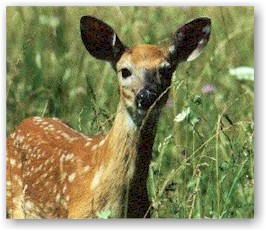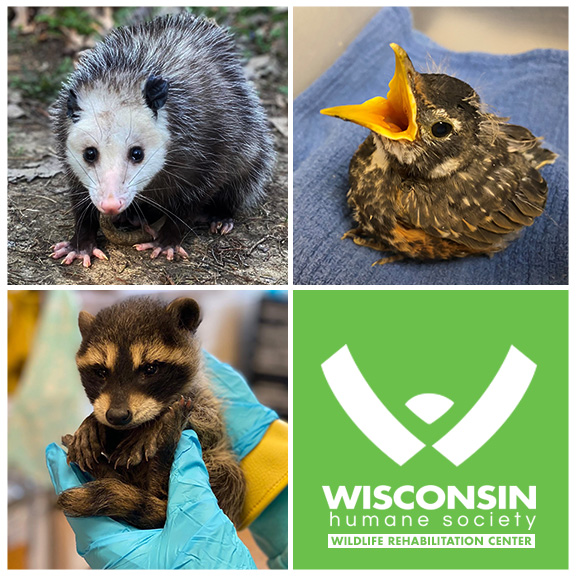Fawns
CLICK HERE for a print-friendly version!
Situation:
You've found a fawn and you suspect it might be orphaned.
Why this happens:
A fawn won't be strong enough to follow her mother or to run from danger until at least two to three weeks of age. So when a young fawn is not actively nursing, the doe will hide her fawn by forcing it to lie down in a location the doe thinks is safe. Fawns are born with almost no scent and as long as they lie still, their spotted coat provides good camouflage to hide them from pedators. So they will often lie still all day, even when people are nearby. The doe then moves some distance away to avoid attracting attention to her fawn, however, she is usually feeding or resting within earshot, ready to respond to her fawn's cries.
FAQs & Humane Solutions:
"I found a fawn bedded down in my yard and I haven't seen the mother all day. What should I do?"
For up to the first three weeks of life, fawns are too weak to follow their mother through her daily routine. So the mother hides her baby in what she considers to be a safe place. In a suburban setting, this “safe place” might be in your garden, or in the shrubs under your neighbor’s kitchen window. The fawn will lie still for hours, relying on its camouflaged, white-spotted coat to keep it hidden from predators.
Sometime during the course of the day the fawn may get up to stretch its legs or move to another spot nearby. This is perfectly normal behavior. Deer have scent glands in-between their hooves. If the fawn moves from its original location, the doe can find her baby by following the fawn’s scent trail. She can also call to her fawn to get the little one to come to her.
The doe will return several times during the day and night to nurse and groom her fawn. The doe is usually quite secretive when she returns to feed her baby. If she doesn’t feel that it is safe to return, for instance, if there are people, dogs, or other potential dangers nearby, she may postpone one or more feedings until she thinks it is safe to return.
In these cases, the best thing to do is NOTHING. Keep children and pets away from the area where the fawn is bedded so that the doe can return to nurse her fawn.
“I have a crying fawn walking around in my yard. There is no mother in sight. What should I do?”
A fawn that is crying (“bleating”) is calling for its mother. It may do this because it is a young fawn that has missed a feeding or two and is very hungry, or it may be an older fawn that has become separated from its mother. In these cases, it is usually best to observe the fawn from a location where neither the fawn nor its mother can see you, such as from inside your house. Give it at least a couple of hours to see if the fawn settles down and stops crying; you may be lucky enough to actually observe the mother coming back to rejoin her fawn. In a suburban setting, it is not unusual for a doe to not be able to hear its fawn’s cries due to noise from nearby traffic, lawn mower engines, or other background noise. It may be nightfall, when the sounds of human activity subside, before the doe and fawn can reunite.
If a fawn goes on crying for hours, we recommend that you contact a licensed wildlife rehabilitator in your area for further advice. If you are in Milwaukee County, you are welcome to call us at 414-431-6204. If you are elsewhere in Wisconsin, click here. If you can’t find a rehabilitator near you, you can call the Wisconsin Department of Natural Resources at (608) 267-0866 to see if they can assist you in finding a licensed rehabilitator.
“I found a fawn walking around in a parking lot. There is no mother in sight. What should I do?”
It is not unusual for a fawn that is not quite old enough to follow its mother full-time to get up and move around a bit when mom is not there. Just a few steps can take a fawn from a relatively safe spot into a potentially more exposed or dangerous area. If the fawn is quietly walking around and is not in immediate danger, it is usually best to stay away and let the fawn find its way back to protective cover. However, if the fawn is in imminent danger from nearby vehicle traffic or other hazards, you may wish to slowly, quietly, and gently try to guide the fawn away from hazards and back to safety, being careful to watch out for your own safety as you do so.
“A doe was just killed by a car and there is a fawn standing nearby! What should I do?”
First, if needed, call 911 to get the assistance of law enforcement personnel in controlling traffic or otherwise protecting human and animal safety at the scene. If it is safe for you to do so and you wish to intervene, you may be able to gently and quietly guide the fawn away from the danger of the roadway and into a safer area. Immediately contact a licensed wildlife rehabilitator in your area for further advice. If you are in Milwaukee County, you are welcome to call us at 414-431-6204. If you are elsewhere in Wisconsin, click here. If you can’t find a rehabilitator near you, you can call the Wisconsin Department of Natural Resources at (608) 267-0866 to see if they can assist you in finding a licensed rehabilitator.
“My kids just came in from outdoors and they were carrying a fawn they found! What should I do?”
It is VERY IMPORTANT that a healthy fawn be placed back where it was found! It is not true that a doe will abandon her fawn because people have touched it. The kids found the fawn because babies three weeks or younger are too weak to follow their mother through her daily routine. So the mother hides her baby in what she considers to be a safe place and returns periodically to feed and care for it. In a suburban setting, this “safe place” might be in your garden, or in the shrubs under your neighbor’s kitchen window. The fawn will lie still for hours, relying on its camouflaged, white-spotted coat to keep it hidden from predators.
If the fawn was found in an unsafe location such as very close to a road or on a parking lot, place the fawn in a safe location as close as possible to the location it was originally found. The doe should be able to find her fawn.
“We found a fawn that looks like it’s sick or injured; it’s lying flat on its side and there are flies on it. What should we do?”
A fawn found in this condition is in serious trouble. If it is to have any chance to survive, it will need the help of a licensed wildlife rehabilitator. We recommend that you immediately contact a licensed wildlife rehabilitator in your area for further advice. If you are in Milwaukee County, you are welcome to call us at 414-431-6204. If you are elsewhere in Wisconsin, click here. If you can’t find a rehabilitator near you, you can call the Wisconsin Department of Natural Resources at (608) 267-0866 to see if they can assist you in finding a licensed rehabilitator.
“I’ve heard that there are certain counties in Wisconsin in which the rehabilitation of deer, including raising orphaned fawns, is prohibited. Is this true?”
Yes, this is true. As part of their plan to combat Chronic Wasting Disease (CWD), the Wisconsin Department of Natural Resources has established bans on deer rehabilitation in most of the counties in the southern half of Wisconsin. In these counties, wildlife rehabilitators can still provide advice to callers with questions about a fawn they have found, can help immediately return healthy fawns to their mothers, and can euthanize deer, but they cannot raise orphaned deer, nor can a fawn be taken from the wild and placed in a deer farm or other captive situation.
This makes it extra-important that a healthy fawn that you find be left, or immediately returned, to where it was found!

.png)

